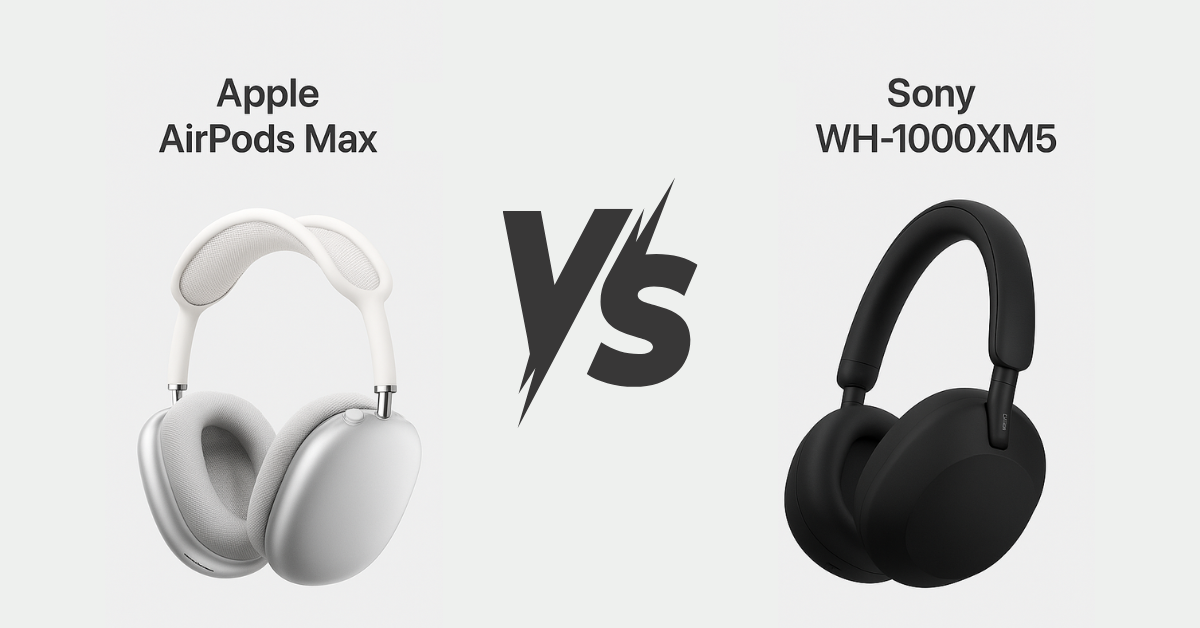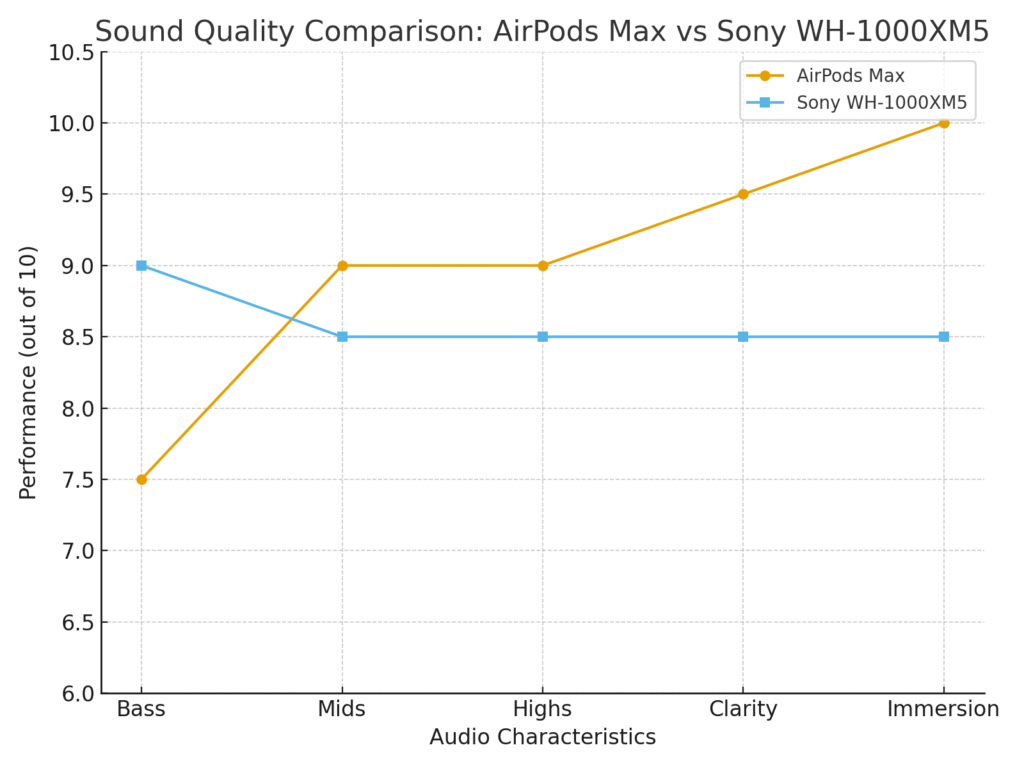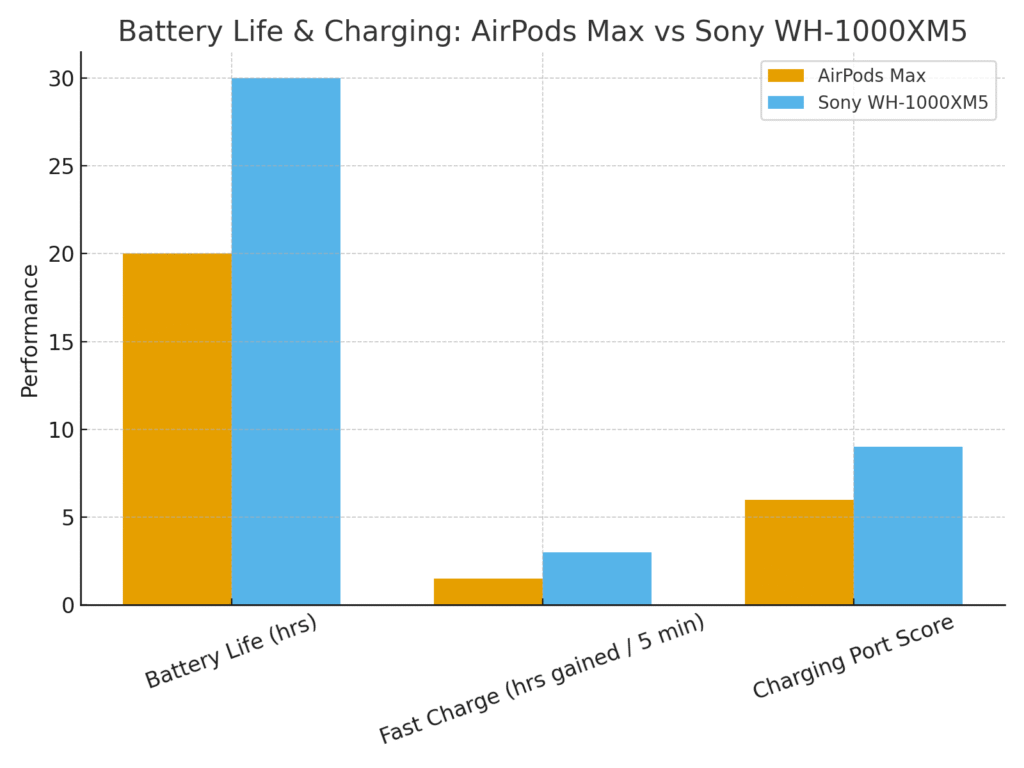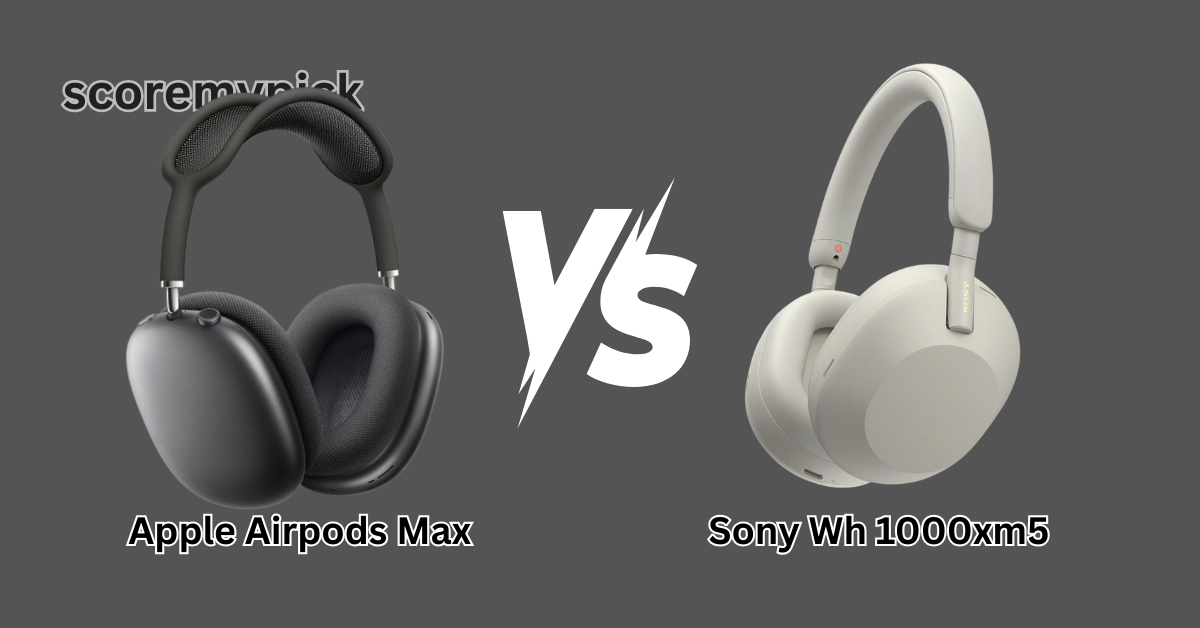Regarding high-end noise-cancelling headphones, there are two giants among the rest, which are Apple AirPods Max and Sony WH-1000XM5. Both are created by those who seek more than just good sound; they desire style, comfort, advanced features and a truly immersive listening experience.
The Apple brand promises luxury, up-to-date ecosystem integration, and Sony promises performance, versatility and naked value. However, these two being of the highest range of the market, the question to ask is–which among the two is the better one to go for?
In this comparison, we’ll break down every detail—design, comfort, sound quality, noise cancellation, features, battery life, and overall value—so you can decide which headphone fits your lifestyle.
Design and Comfort – Luxury Feel vs Practical Elegance
The first thing you notice about any pair of headphones is how they look and feel. Apple and Sony have taken very different approaches here, and the differences are clear the moment you hold them.
The AirPods Max are unmistakably Apple—minimalist, bold, and built with premium materials like anodized aluminum ear cups, stainless steel headband, and memory foam cushions. They have a certain “luxury gadget” vibe that makes them feel like more than just headphones.
The mesh canopy on the headband is designed to reduce pressure on your head, making it surprisingly comfortable despite weighing more than most competitors. However, at 384 grams, the AirPods Max are significantly heavier than the Sony WH-1000XM5, which might cause fatigue during long listening sessions.

On the other hand, Sony WH-1000XM5 takes a lighter and more understated approach. Weighing only 250 grams, they are designed for comfort above all. The headband uses soft synthetic leather, and the ear cups are slim yet padded enough for all-day wear.
While they may not have the same premium “metal and luxury” feel as Apple, they make up for it with practical elegance—headphones that you can wear on a flight, in the office, or even during long commutes without discomfort.
From a design perspective, the AirPods Max stand out as a fashion statement and feel like a luxury accessory. Sony, however, wins when it comes to lightweight comfort and portability, especially for people who use headphones for hours at a stretch.
Sound Quality – Apple’s Clarity vs Sony’s Versatility
Sound is where the real magic happens, and both Apple and Sony deliver outstanding performance—but in very different ways.
The AirPods Max are tuned for balance and clarity. Apple focuses on giving you a natural, studio-like sound where every instrument and voice feels crisp and well-separated. The bass is strong but not overwhelming, the mids are clear, and the highs sparkle without distortion.
Add Spatial Audio with dynamic head tracking, and you get a cinema-like experience when watching movies or listening to Dolby Atmos tracks on Apple Music. It feels immersive, almost like you’re inside the song.
Meanwhile, the Sony WH-1000XM5 aims for versatility. Sony gives you punchy bass, smooth mids, and customizable highs through its Headphones Connect app.

You can adjust the EQ, boost bass, or fine-tune sound to your taste—something Apple doesn’t allow. Sony also supports LDAC, a high-resolution Bluetooth codec that preserves more audio detail, making it a favorite among Android audiophiles.
If you want clean, natural, out-of-the-box sound with an added cinematic experience, AirPods Max take the lead. But if you love customization, powerful bass, and flexibility across devices, the Sony WH-1000XM5 is the better pick.
Noise Cancellation and Transparency Mode – Silence Done Differently
Both Apple and Sony are leaders in Active Noise Cancellation (ANC), but they take slightly different approaches to creating silence.
The AirPods Max use computational audio with nine microphones to block out unwanted sounds. In real-world use—whether on a plane, in a busy café, or walking through traffic—they create a bubble of silence that feels almost unreal. The Transparency Mode is also one of the best in the industry. It lets outside sounds in so naturally that you might forget you’re wearing headphones. Voices remain crystal clear, making conversations effortless.
The Sony WH-1000XM5 uses two processors and eight microphones for ANC. Sony’s system adapts to your environment automatically, adjusting the noise cancellation depending on where you are. On a flight, it cancels out the engine hum perfectly, while in the city, it lowers wind noise and traffic sounds intelligently. The Ambient Sound Mode is great, though slightly less natural than Apple’s Transparency Mode.
In short:
- AirPods Max excel at transparency and natural listening.
- Sony WH-1000XM5 leads with a smart adaptive ANC that works everywhere.
Both are outstanding, but your choice depends on whether you value natural awareness (Apple) or adaptive silence (Sony).
Smart Features and Connectivity – Ecosystem vs Flexibility
Here’s where the biggest difference shows: Apple locks you into its ecosystem, while Sony gives you freedom.
With the AirPods Max, everything feels magical if you’re an iPhone, iPad, or Mac user. They switch automatically between your Apple devices, work seamlessly with Find My, and deliver the best experience with Apple Music’s Spatial Audio.
Siri integration is smooth, and you don’t need to think about pairing—it just works. The downside? Limited codec support. AirPods Max only use AAC over Bluetooth, so if you’re on Android, you don’t get the same high-quality audio experience.
The Sony WH-1000XM5, on the other hand, is all about flexibility. They connect to two devices at once, so you can switch between your laptop and phone without hassle.
They support LDAC for high-resolution audio, making them excellent for Android users and audiophiles. Sony also includes support for Google Assistant and Alexa, giving you more control options. The touch controls on the earcups are smooth and easy once you get used to them.
So, if you’re deep in the Apple ecosystem, the AirPods Max are unbeatable. But if you want multi-device freedom, codec support, and broader compatibility, Sony wins this round.
Battery Life and Charging – Longevity vs Quick Boost
Battery life is a deciding factor for many, especially if you use headphones on long trips or during work. Here, Sony takes the lead in endurance, but Apple has a few tricks of its own.
The AirPods Max offer 20 hours of listening time with Active Noise Cancellation and Spatial Audio enabled. While that’s enough for a full day of use, it falls short compared to Sony. Apple does include fast charging—just 5 minutes of charge gives you about 1.5 hours of playback, which is handy when you’re rushing out. However, charging through a Lightning cable feels outdated in today’s world of USB-C, especially for such a premium device.

The Sony WH-1000XM5 shines here with 30 hours of battery life on a full charge, and even 40 hours if ANC is turned off. That’s a big difference, especially for frequent travelers. Sony also provides quick charging—3 minutes of charge gives you around 3 hours of playback. And importantly, it uses USB-C, the universal standard that works with most modern devices.
In real-world use:
- AirPods Max: Great for daily charging habits but not built for marathon travelers.
- Sony WH-1000XM5: Perfect for long flights, road trips, or anyone who doesn’t want to recharge too often.
Price and Value – Is Luxury Worth It?
Both headphones are premium, but they sit in different pricing philosophies.
The Apple AirPods Max usually retail around $549, placing them firmly in the luxury segment. Apple is not just selling sound; they’re selling design, build quality, and seamless integration with the Apple ecosystem. For many, it feels like buying an accessory that matches their iPhone and MacBook rather than just a pair of headphones.
The Sony WH-1000XM5 retails around $399 (often discounted lower), which makes them $150+ cheaper than the AirPods Max. Despite the lower price, Sony doesn’t cut corners on sound, ANC, or comfort. In fact, many would argue you get more value for your money because you’re paying for performance rather than luxury branding.
So, the question is: Do you value Apple’s luxury design and ecosystem perks enough to pay more, or do you prefer Sony’s practical balance of price and performance?
Final Verdict – Which One Should You Buy?
At the end of the day, both the AirPods Max and Sony WH-1000XM5 are excellent headphones—but they serve slightly different audiences.
Choose the Apple AirPods Max if you:
- Are deeply invested in the Apple ecosystem (iPhone, iPad, Mac).
- Want unmatched Transparency Mode and immersive Spatial Audio.
- Appreciate premium materials and a luxury design.
Choose the Sony WH-1000XM5 if you:
- Want longer battery life and USB-C convenience.
- Value sound customization and high-resolution audio (LDAC).
- Prefer lightweight comfort for long listening sessions.
- Want better overall value for money.
Final Word: If you’re an Apple loyalist, the AirPods Max will feel magical and worth the investment. But if you want the best combination of price, performance, and versatility, the Sony WH-1000XM5 is the smarter choice for most people.
FAQs
Do AirPods Max sound better than Sony XM5?
AirPods Max offer clearer highs and immersive Spatial Audio, while Sony XM5 provides stronger bass and customizable sound. The “better” choice depends on your listening style.
Is the AirPod Max better than the Sony?
AirPods Max excel in design and Apple ecosystem integration, but Sony headphones are lighter, cheaper, and offer longer battery life. Each is better in different ways.
Is the Sony WF-1000XM5 better than AirPods?
Sony WF-1000XM5 earbuds deliver richer sound and better noise cancellation than standard AirPods. However, AirPods Pro compete more closely in ecosystem and usability.
Is the Sony WH-1000XM4 better than the Apple?
Sony WH-1000XM4 are more affordable, lighter, and have great ANC, while AirPods Max bring premium build and Spatial Audio. Which is “better” depends on budget and ecosystem needs.

